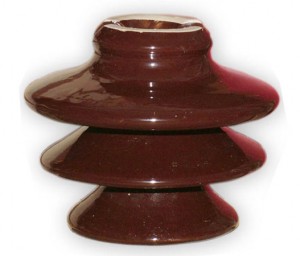A Pin insulator consists of a non-conducting material such as Porcelain, Glass, Plastic, Polymer, or Wood that is formed into a shape that will isolate a wire from a physical support (or “pin”) on a telegraph, utility pole or other structure, provide a means to hold the insulator to the pin, and provide a means to secure the conductor to the insulator. By contrast to a strain insulator, the pin insulator is directly connected to the supporting pole. The earliest pin insulators predate the strain insulator and were deployed before about 1830. Pin insulators continue in production with manufacturers worldwide.
The Pin insulator is designed to secure the conductor to itself. The most common way to do this is to use a wire to tie the conductor to the insulator. Another method is to design the insulator with self-typing features such as complex slots and grooves formed into the insulator. Finally, for heavy conductors, gravity can be used to hold the conductor in place.
Pin insulator are almost always deployed in the open air, so isolation when wet is a major consideration. To combat this problem, pin insulators feature extra skirts or wide shells to increase the surface distance between the conductor and the pin.
The “pin” is typically a wooden or metal dowel of about 3 cm diameter with screw threads. The pin insulator has threads so that it can be screwed onto the pin. A typical pin insulator is more than 10 cm in diameter and weighs one kg or more. Size depends on the voltage to be isolated and the weight of span of wire to be supported.

